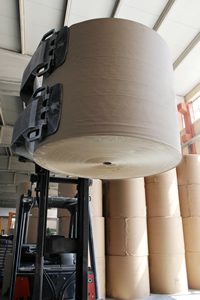[breadcrumb]
How a Paper Mill Worker Can Get Mesothelioma by Occupational Exposure to Asbestos
Paper products were historically made from a variety of materials, including asbestos. In 1972, 9% of the United States’ consumption of asbestos was for paper products. During the 1970s, paper products were comprised 30% to 90% asbestos.
Asbestos was also used to insulate pipes and vessels. One group of paper mill workers who were at an increased risk of being exposed to asbestos were maintenance workers. Maintenance workers would inspect these asbestos-insulated pipes and boilers. They would also work on paper-making machinery that had asbestos. Maintenance workers would open these machines to check that passageways were clear and heating elements were properly working. During these tasks, maintenance workers could breathe in asbestos fibers from the insulation and heating element holders.
Paper mills were also often constructed with various asbestos-containing materials, so any type of worker could potentially be exposed to dangerous asbestos fibers.
Locations in the United States with the Highest Employment Rates for Paper Mill Workers
According to the United States Bureau of Labor Statistics, there are currently 96,770 workers currently employed in pulp, paper and paperboard mills. States with the highest employment rates for paper mill workers include:
- Wisconsin
- California
- New York
- Illinois
- Pennsylvania
- Texas
Similar Occupations as Paper Mill Workers
Similar occupations as paper mill workers include:
- Cementing and gluing machine operators and tenders
- Metal and plastic cutters
- Packaging and filling machine operators and tenders
- Punching and pressing setters, operators and tenders
- Sawing machine setters, operators and tenders
- Textile cutting machine setters, operators and tenders
- Welders, solderers and brazers
- Wood working machine setters, operators and tenders
Lawsuits and Settlements Involving Paper Mill Workers
There have been several successful lawsuits brought by paper mill workers who were exposed to asbestos. A Seattle, Washington jury awarded $10.2 million in 2009 to a retired Washington paper mill worker against Scapa Dryer Fabrics, Inc. and AstenJohnson Inc. when the court found his work exposed him to asbestos when he came in contact with asbestos-containing dryer felts produced by the defendants. The jury found the defendants defectively designed the dryer fabrics and had a defective warning because no warnings of the hazards were communicated to consumers. The award included $700,000 in compensation for medical expenses, loss of future income and loss of household services, $8 million in non-economic damages and $1.5 million for the man’s wife for loss of consortium.
The family of a 66-year-old paper mill worker received nearly $4 million in 2014 when a Portland jury found that the death of a former insulation worker who died of malignant mesothelioma in 2011 was caused by the defendants. He was exposed to asbestos while working as an insulation helper at Pacific Northwest paper mills operated by the defendants.
Studies Related to Paper Mills and Asbestos
Several studies have identified the connection between paper mills and asbestos exposure. An International Agency for Research on Cancer study published in 2002 found that 36% of pulp and paper workers had been exposed to asbestos, suggesting that these workers have an increased risk of mesothelioma and pleural cancer due to this exposure. A health screening conducted by the Minnesota Department of Health reached similar results, finding that 27% of paper workers who worked at a plant producing paper ceiling tiles and fiber board from 1958 to 1974 and their spouses had health abnormalities consistent with asbestos exposure.
A Swedish study found an increased risk of pleural mesothelioma among workers in paper mills. Researchers found 71% of workers had been exposed to asbestos and many of these worked in maintenance occupations.
A British Columbia study found that paper and pulp mill workers who had been exposed to asbestos had an increased risk of developing cancer.
A pleural cancer study among employees at paper and pulp mills found that fatalities stemming from asbestos exposure were most likely to occur in maintenance workers.
Types of Asbestos Products Used by Paper Mill Workers
Paper mill workers may have been exposed to asbestos products in a variety of applications, including from paper mill equipment and materials. Many machines were insulated with asbestos. Additionally, materials used during the process contained asbestos, including drying machines, sandpaper backing and talc.
Paper mill workers could have also been exposed to insulation in building components, such as insulation that was installed in walls, doors, piping and boilers. Other building materials that may have exposed paper mill workers to asbestos were industrial adhesives, paint, cement, roofing shingles, siding, floor tiles, ceiling tiles and packing material.
Manufacturers of Asbestos Products Used by Paper Mill Workers
Manufacturers known to have made asbestos products that were used in paper mills include:
- Albany Felt Company
- Champion International
- Finch, Pruyn & Co.
- Kimberly-Clark
- International Paper Company
A number of manufacturers have been named as defendants in asbestos litigation for allegedly exposing paper mill workers, including the following:
- AstenJohnson Inc.
- Georgia-Pacific
- Kaiser Aluminum
- Scapa Dryer Fabrics, Inc.
- R. Grace Co.

